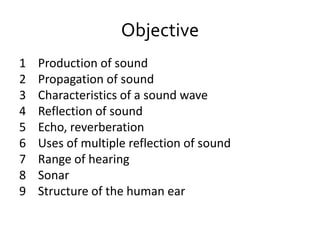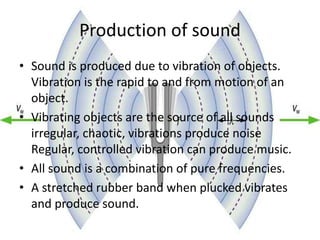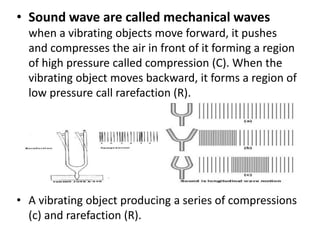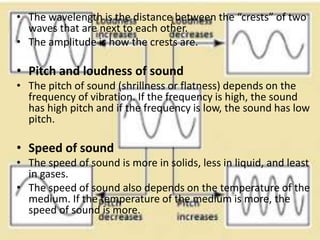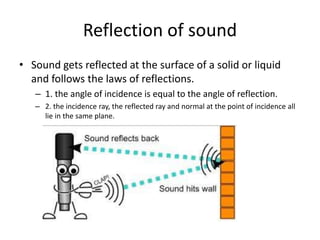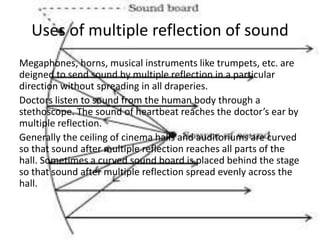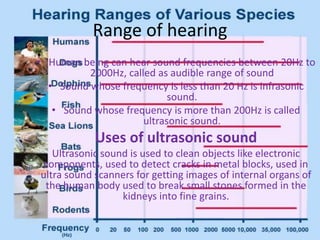Sound
- 2. Objective 1 Production of sound 2 Propagation of sound 3 Characteristics of a sound wave 4 Reflection of sound 5 Echo, reverberation 6 Uses of multiple reflection of sound 7 Range of hearing 8 Sonar 9 Structure of the human ear
- 3. Production of sound • Sound is produced due to vibration of objects. Vibration is the rapid to and from motion of an object. • Vibrating objects are the source of all sounds irregular, chaotic, vibrations produce noise Regular, controlled vibration can produce music. • All sound is a combination of pure frequencies. • A stretched rubber band when plucked vibrates and produce sound.
- 4. Propagation of sound • When an object vibrates, the particles around the medium vibrates. • The particles in contact with the vibrating objects is the first displaced from its equilibrium position. • The disturbance produced by the vibrating body travels through the medium but the particles do not move forward themselves. • A wave is a disturbance which moves through a medium by the vibration of the particles of the medium. • So sound is considered as a wave, sound wave require medium for transmission.
- 5. • Sound wave are called mechanical waves when a vibrating objects move forward, it pushes and compresses the air in front of it forming a region of high pressure called compression (C). When the vibrating object moves backward, it forms a region of low pressure call rarefaction (R). • A vibrating object producing a series of compressions (c) and rarefaction (R).
- 6. • In theses waves the particles move back and forth parallel to the direction of propagation of the disturbance. Such waves are called longitudinal waves. • There is another kind of waves called transverse waves. In these waves the particles oscillate up and down perpendicular to the propagation of the direction of disturbance. • Sound propagates in a medium as a series of (C) and (R). • (C) are the regions of high pressure and density where the particles are crowed andare represented by the upper portion of the curve called crest. • (R) are the regions of low pressure and density where the particles are spread out and are represented by the lower portion of the curve called trough.
- 7. Characteristics of a sound Frequency of sound wave The number of oscillations per unit time is called frequency of the sound wave. It is represented by the symbol v ( Greek letter nu). Its SI unit is hertz (Hz). distance condensation rarefaction wavelength wavelengthwavelengthwavelength pressure
- 8. Time period of sound wave: • The time taken by wave to complete one oscillation is called time-period. • Frequency and time are represented as follows:- • V = 1/v OR 1/T Amplitude of sound wave • The amplitude of sound wave is the height of the crest or tough. • It is represented by the letter A. • The SI unit is the same as that of the density or pressure.
- 9. • The wavelength is the distance between the “crests” of two waves that are next to each other. • The amplitude is how the crests are. • Pitch and loudness of sound • The pitch of sound (shrillness or flatness) depends on the frequency of vibration. If the frequency is high, the sound has high pitch and if the frequency is low, the sound has low pitch. • Speed of sound • The speed of sound is more in solids, less in liquid, and least in gases. • The speed of sound also depends on the temperature of the medium. If the temperature of the medium is more, the speed of sound is more.
- 10. Reflection of sound • Sound gets reflected at the surface of a solid or liquid and follows the laws of reflections. – 1. the angle of incidence is equal to the angle of reflection. – 2. the incidence ray, the reflected ray and normal at the point of incidence all lie in the same plane.
- 11. Echo • If we shout or clap near a reflecting surface like tall building or a mountain, we hear the same sound again. • This sound which we hear is called echo. • It is caused due to the reflection of sound. • To hear an echo clearly, the time interval between the original sound and the echo sound must be at least 0.1second • Since the speed of sound in air is 344m/s, the distance travelled by sound in 0.1s = 344 • m/s x 0.1 s = 34.4 m. so to hear an echo clearly, the minimum distance of the reflecting surface should be half this distance that I s17.2m.
- 12. Reverberation • Echoes may be heard more than once due to repeated or multiple reflections of sound from several reflecting surfaces. This cause persistence of sound called reverberation. • In big halls or auditorium to reduce reverberation, the roofs and walls are covered by sound absorbing materials like compressed fiber boards, rough plaster or draperies.
- 13. Uses of multiple reflection of sound Megaphones, horns, musical instruments like trumpets, etc. are deigned to send sound by multiple reflection in a particular direction without spreading in all draperies. Doctors listen to sound from the human body through a stethoscope. The sound of heartbeat reaches the doctor’s ear by multiple reflection. Generally the ceiling of cinema halls and auditoriums are curved so that sound after multiple reflection reaches all parts of the hall. Sometimes a curved sound board is placed behind the stage so that sound after multiple reflection spread evenly across the hall.
- 14. Range of hearing • Human being can hear sound frequencies between 20Hz to 2000Hz, called as audible range of sound • Sound whose frequency is less than 20 Hz is infrasonic sound. • Sound whose frequency is more than 200Hz is called ultrasonic sound. Uses of ultrasonic sound Ultrasonic sound is used to clean objects like electronic components, used to detect cracks in metal blocks, used in ultra sound scanners for getting images of internal organs of the human body used to break small stones formed in the kidneys into fine grains.
- 15. Sonar • It is a device which uses ultrasonic waves to measure distance and speed of underwater objects. • The distance of the objects can be calculated by knowing the speed of sound in water and the time taken between the transmission and reception of ultrasound.
- 16. Structure of the human ear • The sound waves passes through the ear canal to a thin membrane called eardrum. The eardrum vibrates. • The vibrations are amplified by the three bones of the middle ear called hammer, anvil and stirrup. • Middle ear then transmits the sound waves to the inner ear. • The brain then interprets the signals as sound.

